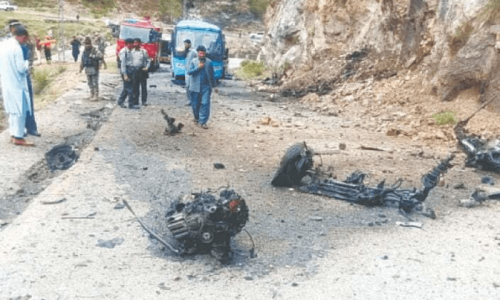THE Shangla terrorist attack on the Chinese engineers’ vehicle is having consequences. Chinese companies have suspended work on at least three critical hydropower projects: the Dasu dam, the Diamer-Basha dam, and the Tarbela 5th Extension.
The attack has caused significant alarm. Apart from disrupting these vital infrastructure projects, it has shaken the confidence of Chinese nationals working in Pakistan. Reports indicate some are considering leaving the country due to safety concerns.
The Pakistani government has repeatedly pledged to bring the perpetrators to justice. However, the recent incident has eroded trust. Chinese social media reflects growing anxiety, with calls for stricter security measures to protect Chinese lives.
Whenever a major terrorist incident occurs in the country, the media, security experts, and even state institutions start to make sweeping generalisations about the event, the culprits, their motives, and the terrorist groups that could have been involved in such incidents.
The first and most well-known excuse cited is foreign involvement in the attacks, especially those targeting Chinese nationals or CPEC-related projects. Three names of terrorist groups spring to mind: Tehreek-e-Taliban Pakistan (TTP), Balochistan Liberation Army, and the Islamic State-Khorasan. They guess a specific group’s involvement depends on the region; these three groups have specific operational bases.
The same is the case for the recent Shangla attack. The names of all three groups popped up immediately after the attack. The TTP has been projected as the prime suspect, as one of its commanders was declared the mastermind behind a similar attack on the Chinese in Kohistan in 2021. The names of a few TTP commanders who may have orchestrated the attack are circulating in the media. Quickly jumping to conclusions distracts investigation and impacts the state’s ability to tackle the security situation comprehensively.
The state’s history of compromise with militant groups has emboldened them.
Pakistan’s militant landscape may not be too complex but is diverse. Ideologies, sociopolitical factors, and group dynamics all work within local contexts. In any counterterrorism inquiry, local context and dynamics are more important than broader ideological and political motivations.
Shangla, upper and lower Kohistan, and Battagram districts of the Hazara region in KP and the adjoining Diamer district in Gilgit-Baltistan share religious, social, tribal, ethnic, and cultural codes. The region has been frequently in the news due to ‘honour’ killings, burning of girls’ schools, and the killing of Shia travellers. Recently, it has gained notoriety for attacks on Chinese workers involved in development projects in the area.
The Deobandi school is dominant in the region and blends with conservative social traditions, particularly the honour code. The resultant insularity has led to frequent interactions between the locals and Deobandi madressahs, as well as sectarian and militant outfits in the country. The locals support these religious organisations, giving them financial and human resources, and weapons. Before receiving large compensation sums for the Dasu and Basha dams, the region thrived on timber smuggling.
Extremist tendencies in the region are stronger than those in the neighbouring areas. Anti-Shia sentiment, blood feuds in the community, and a sense of ethnic superiority are ingrained.
The region has always been difficult to govern. Security institutions, bureaucracy, and the area’s political leadership have tried to run the administration — while compromising on laws and rules. Even in cases of major disputes, the administration tries to resolve them through local jirgas and by involving religious scholars. This can result in leniency towards criminals, with many extremist elements taking the law into their own hands.
The Mujahideen Gilgit-Baltistan and Kohistan (MGB) are a prime example. The group claimed responsibility for several incidents in Kohistan and Diamer districts.
In October 2022, it held a GB minister hostage. They demanded the release of terrorists — some of them had been involved in the 2013 terrorist attack on the Nanga Parbat base camp targeting foreign climbers — and an end to women’s sporting activities in GB for the minister’s release. They claimed they blocked the road because the state failed to honour a 2019 agreement, and issued a 10-day ultimatum for the government to meet their demands.
Although a prominent violent actor, it is not the only one in the region. The MGB and other local militant groups reportedly maintain close links with the TTP and sectarian outfits based in Punjab. These external groups appear to support local militants, as evidenced by the TTP’s involvement in the 2022 Babusar Pass blockade. The state’s history of compromise with militant groups has emboldened them. For instance, in the kidnapping incident, the administration agreed to ban girls’ sports in the region. Similarly, a 2019 agreement had reportedly allowed for implementation of some Islamic laws the militants had demanded.
The state’s reliance on religious scholars for mediation in crises can be problematic. Local accounts suggest that some scholars may be sympathetic to the militants’ demands, leading to partial concessions that create a perception of a ‘win-win’ scenario for militants and religious figures.
But the question is: why are an increasing number of Chinese nationals being targeted in these areas, which are seemingly benefiting from the development projects?
While anti-development sentiments are not that high in the area, many believe that dams and wider roads will trigger urbanisation, women’s emancipation, and modernisation, which they perceive as threats to their religion and culture. The dominant trend suggests that most people are happy with the compensation money and employment prospects.
However, this doesn’t diminish the level of religious extremism present. Some residents may sympathise with the Uighur community in Xinjiang, and others may dislike the presence of foreigners on their land. These factors could be nurturing negative perceptions about Chinese nationals in the region.
One possible example of the local dynamics is seen in the blasphemy accusation against a Chinese official at the Dasu dam site last year. The incident highlighted that tensions could erupt.
While local groups may lack the capability to carry out large-scale attacks independently, past events like the killing of Shia passengers and the attack on tourists at Nanga Parbat demonstrate their capacity for violence. Their ability is amplified by support from like-minded groups within Pakistan and Afghanistan.
The government’s strategy of outsourcing the maintenance of order to local and external religious figures needs to be revised to address these sentiments. A more comprehensive approach is needed to calm tensions.
The writer is a security analyst.
Published in Dawn, March 31st, 2024














































